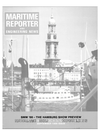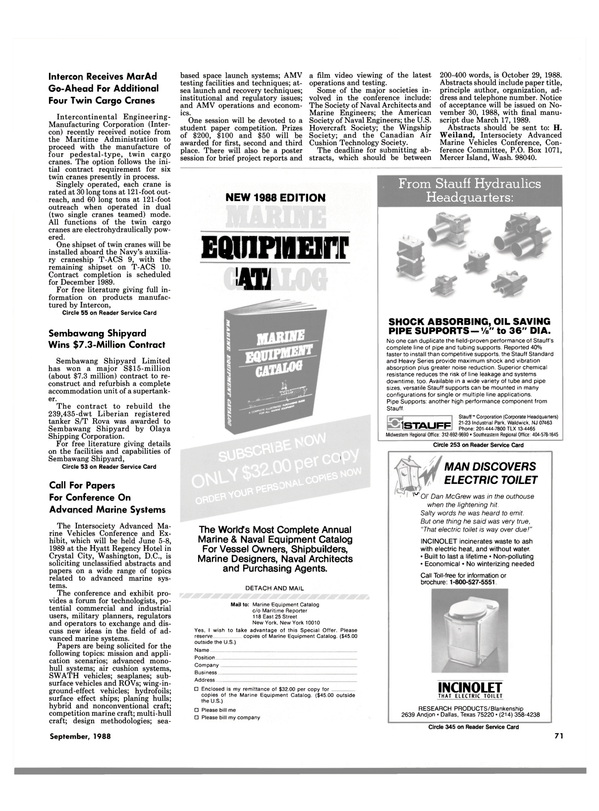
New Propeller Boss Cap Fins Provide Significant Improvement In Efficiency
result of concentrated research effort for the past two years, Propeller Boss Cap Fins (PBCF) are said to show significant economic features for all vessels.
To date, research for improving propeller efficiency due to vortexes in the slipstream of the propeller has concentrated on the loss of efficiency due to the propeller tip vortex.
There have been many designs and devices tested for reducing this effect.
Until recently, very little research has concentrated on the efficiency loss due to the propeller hub or boss.
Theoretical calculations for propeller performance which includes the influence of the hub have only recently become possible.
The result of joint research efforts by Mitsui OSK Lines Ltd., West Japan Fluid Engineering Laboratory Co. Ltd., and Mikado Propeller Co. Ltd. since September 1986, PBCF is designed to decrease the induced resistance due to the vortexes generated by the boss cap.
PBCF is a simple device, having the same number of fins attached to the boss cap as that of the ship's propeller. The fins serve to control the flow over the propeller hub, thus diffusing the vortexes created by the hub. This effect is seen clearly in the two photographs of the model tests, included with this article. Pro- peller open water model tests have shown gains in efficiency of 3 percent to 7 percent and resistance/ self-propulsion tests conducted on a 6-meter model indicated gains of 2 percent to 5 percent. A graphical summary of the model tests are shown in Fig. 1.
Speed trials conducted in September 1987 for the Mercury Ace, a 44,979-grt car carrier of Mitsui OSK Lines Ltd., fitted with PBCF, demonstrated a real ship efficiency improvement of 4 percent. Trials were conducted simultaneously with a like sister ship without PBCF. Fig.
2 shows the graphical results of these trials.
On-ship trials have also shown that installation of PBCF has no effect on maneuverability.
As PBCF controls the flow behind the propeller—it has little dependence on the hull form like other energy-saving devices. As a result, PBCF is effective on ships of any type. PCBF is said to be especially effective for high-speed ships with a high propeller pitch ratio.
Smaller and lighter than conventional energy-saving devices set around the propeller, PBCF can also be manufactured at low cost.
The investment can be recovered in as little as one year.
An important feature is that installation of PBCF can be performed in a very short period of time for a new ship under construction or a ship in operation. Installation simply requires the removal and replacement of the propeller boss cap with PBCF. With a ship in drydock, this can be accomplished in only four to five hours. The added weight also has an insignificant effect on shaft alignment and bearing loads.
Since January of this year, PBCF has been fitted on over 23 ships of several types. All are said to have experienced significant increases in propulsion efficiency ranging from 3.2 percent to 6.7 percent. The average increase in efficiency has been 4.2 percent For more information and a copy of the technical paper on the development of PBCF, Circle 8 on Reader Service Card
Read New Propeller Boss Cap Fins Provide Significant Improvement In Efficiency in Pdf, Flash or Html5 edition of September 1988 Maritime Reporter
Other stories from September 1988 issue
Content
- Officine Mariotti Yard To Perform Conversion For $118.8 Million page: 4
- Trinity Marine Group Awarded $13-Million Jordanian Contract To Build Five Workboats page: 6
- It's Time To Prepare For MARPOL Compliance* page: 7
- Versatile Pacific Delivers $80-Million Icebreaker 'Henry Larsen' page: 10
- New Radars By Simrad Offer Desirable Selection page: 10
- Ulstein Group Becoming A Major Force In Ship Equipment page: 12
- Dixie Carriers To Build And Operate Barges For Norwegian Firm page: 13
- Wartsila Engines Selected To Power 2 New Bulk Carriers And Re-Engine A Cargo Carrier page: 14
- Korea Shipbuilding Delivering Six Tankers To Norwegian Owners page: 15
- Canadian Government To Spend $624.4 Million For 12 Minesweepers page: 15
- SMM '88 page: 16
- 3.MAJ Diesel Works Builds First Sulzer RTA 72 Engine Ever page: 26
- Kelvin Hughes Successful At Posidonia Exhibition page: 27
- Harris Announces New Digital HF-SSB Radio System page: 28
- Jamesbury Expands Line Of Economical, Corrosion Resistant Vane Actuators page: 28
- MarineSafety Providing Simulator Training For Apprentice Pilots page: 29
- Damaged Navy Frigate Transported From Gulf By Heavylift Ship page: 30
- U.S. NAVY SHIP REPAIR AND MODERNIZATION page: 33
- Major Navy Contracts page: 35
- Ingalls Shipbuilding Christens U.S. Navy Cruiser Chancellorsville page: 38
- Hampton Roads SNAME Discusses Improving Producibility Of American Fast Attack Submarines page: 39
- THE LATEST ADVANCEMENTS IN PROPULSION SYSTEMS FOR TODAY'S NAVIES page: 40
- U.S. Navy Torpedo Boats To Use Omnithruster Hydrojet Systems page: 48
- Moss Point Delivers Third Of Four Logistic Support Vessels To U.S. Army page: 49
- Con-Tech Supplies Siemens Electrical Control Components For Logistic Support Vessels page: 52
- MMA Seeks Executive Secretary page: 55
- Sperry Marine's New Rascar Wins Wide Type-Approval Acceptance page: 56
- USCG Opens Door To Commercial Emergency Towing page: 56
- Seebeckwerft Receives $38.9-Million Order To Build Rail Ferry page: 57
- Autodata Division Of Acurex Expands Data Acquisition Capabilities page: 57
- Watercom Announces New And Expanded Subscriber Service page: 58
- Shipbuilding & Metal Fabrication Conference Set For October 4-5 page: 58
- Sal Berte Forms Saber Communications page: 59
- $40-Million Order Won By AESA For 140,000-Dwt Oil Tanker For CNN page: 59
- Wartsila Completes Conversion And Refurbishment Of S/S Monterey To Luxury-Class Cruise Liner page: 60
- New Propeller Boss Cap Fins Provide Significant Improvement In Efficiency page: 61
- New Joint Venture Formed For China's International Maritime Exhibition page: 65
- Nola Centurion Opens Fabrication Facility In Braithwaite, La. page: 65
- New Lot w-Cost Weather Chart Recorder From Alden Doubles As Computer Printer page: 66
- Raytheon Marine Introduces A Combination Loran With Raster Scan Plotter page: 66
- Devoe Marine And Devoe Napko Coatings Divisions Merge As Devoe Coatings Company page: 70
- Munson Delivers Cummins Triple Engine, Hamilton Jet Boat For Lake Erie Use page: 70
- Call For Papers For Conference On Advanced Marine Systems page: 71
- Yarrow Wins U.K. Frigates Order Worth $538.5 Million page: 72
- Propulsion Plant Debut For MAN B&W's Mini-Bore, Two-Stroke Diesel Engine page: 72
- New Satellite Communications System From Comsat Selected For Blue Riband Competition page: 75
- Samson Sold To Management Group—Will Focus On Expanding Use Of High Performance Ropes page: 75
- Seaward International Delivers 34 Sea Guard Marine Fenders To U.S. Naval Station In Florida page: 75
- Tidewater Marine Acquires Three Vessels In Exchange For Common Stock page: 78
- Swiss Firm Of Eckold AG Offers Free Literature On 'Press-Joining' page: 78


